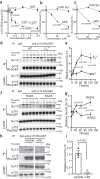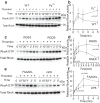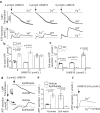Integrin β3 directly inhibits the Gα13-p115RhoGEF interaction to regulate G protein signaling and platelet exocytosis
- PMID: 37587112
- PMCID: PMC10432399
- DOI: 10.1038/s41467-023-40531-3
Integrin β3 directly inhibits the Gα13-p115RhoGEF interaction to regulate G protein signaling and platelet exocytosis
Abstract
The integrins and G protein-coupled receptors are both fundamental in cell biology. The cross talk between these two, however, is unclear. Here we show that β3 integrins negatively regulate G protein-coupled signaling by directly inhibiting the Gα13-p115RhoGEF interaction. Furthermore, whereas β3 deficiency or integrin antagonists inhibit integrin-dependent platelet aggregation and exocytosis (granule secretion), they enhance G protein-coupled RhoA activation and integrin-independent secretion. In contrast, a β3-derived Gα13-binding peptide or Gα13 knockout inhibits G protein-coupled RhoA activation and both integrin-independent and dependent platelet secretion without affecting primary platelet aggregation. In a mouse model of myocardial ischemia/reperfusion injury in vivo, the β3-derived Gα13-binding peptide inhibits platelet secretion of granule constituents, which exacerbates inflammation and ischemia/reperfusion injury. These data establish crucial integrin-G protein crosstalk, providing a rationale for therapeutic approaches that inhibit exocytosis in platelets and possibly other cells without adverse effects associated with loss of cell adhesion.
© 2023. Springer Nature Limited.
Conflict of interest statement
University of Illinois at Chicago holds patents related to this study. X.D. holds equity interests in DMT, Inc., which licenses UIC technology. The remaining authors declare no competing interests.
Figures






Similar articles
-
G protein subunit Galpha13 binds to integrin alphaIIbbeta3 and mediates integrin "outside-in" signaling.Science. 2010 Jan 15;327(5963):340-3. doi: 10.1126/science.1174779. Science. 2010. PMID: 20075254 Free PMC article.
-
Shear-induced integrin signaling in platelet phosphatidylserine exposure, microvesicle release, and coagulation.Blood. 2018 Aug 2;132(5):533-543. doi: 10.1182/blood-2017-05-785253. Epub 2018 May 31. Blood. 2018. PMID: 29853537 Free PMC article.
-
The interaction of Gα13 with integrin β1 mediates cell migration by dynamic regulation of RhoA.Mol Biol Cell. 2015 Oct 15;26(20):3658-70. doi: 10.1091/mbc.E15-05-0274. Epub 2015 Aug 26. Mol Biol Cell. 2015. PMID: 26310447 Free PMC article.
-
Effects of thrombin on interactions between beta3-integrins and extracellular matrix in platelets and vascular cells.Arterioscler Thromb Vasc Biol. 2003 Nov 1;23(11):1971-8. doi: 10.1161/01.ATV.0000093470.51580.0F. Epub 2003 Aug 28. Arterioscler Thromb Vasc Biol. 2003. PMID: 12947018 Review.
-
Beta3 tyrosine phosphorylation in alphaIIbbeta3 (platelet membrane GP IIb-IIIa) outside-in integrin signaling.Thromb Haemost. 2001 Jul;86(1):246-58. Thromb Haemost. 2001. PMID: 11487013 Review.
Cited by
-
Thromboinflammation and the Role of Platelets.Arterioscler Thromb Vasc Biol. 2024 Jun;44(6):1175-1180. doi: 10.1161/ATVBAHA.124.320149. Epub 2024 May 22. Arterioscler Thromb Vasc Biol. 2024. PMID: 38776384 Free PMC article. No abstract available.
-
G12/13 signaling in asthma.Respir Res. 2024 Aug 2;25(1):295. doi: 10.1186/s12931-024-02920-0. Respir Res. 2024. PMID: 39095798 Free PMC article. Review.
-
RAP1-RHO small GTPase cross-talk mediates integrin-dependent and -independent platelet procoagulant response.bioRxiv [Preprint]. 2025 May 23:2025.05.22.655614. doi: 10.1101/2025.05.22.655614. bioRxiv. 2025. PMID: 40475636 Free PMC article. Preprint.
-
ECM remodeling by PDGFRβ+ dental pulp stem cells drives angiogenesis and pulp regeneration via integrin signaling.Stem Cell Res Ther. 2025 Jun 3;16(1):283. doi: 10.1186/s13287-025-04382-7. Stem Cell Res Ther. 2025. PMID: 40462244 Free PMC article.
References
-
- Wootten D, Christopoulos A, Marti-Solano M, Babu MM, Sexton PM. Mechanisms of signalling and biased agonism in G protein-coupled receptors. Nat. Rev. Mol. Cell Biol. 2018;19:638–653. - PubMed
-
- Oldham WM, Hamm HE. Heterotrimeric G protein activation by G-protein-coupled receptors. Nat. Rev. Mol. Cell Biol. 2008;9:60–71. - PubMed
Publication types
MeSH terms
Substances
Grants and funding
LinkOut - more resources
Full Text Sources

